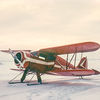Check out Traditional Street and Architectural Photography section of our forum.
Noise
Apr 3, 2018 08:41:19 #
Aside from all the very helpful explanations, it basically comes down to "whats visable". If you would look at a "No Noise" 8X10 print with a magnifiyng glass you would see no noise. Blow that print up to wall size, the closer you get to the print the more noise will be visable. Will there ever be a no noise photo? Not unless the laws of physics are repealed. But the search for perfection is a fools errand.
Apr 3, 2018 09:52:17 #
tdekany wrote:
What iso do you normally shoot at?
But to answer your question directly, google the Sony A7sII. King of high iso.
But to answer your question directly, google the Sony A7sII. King of high iso.
Wow.....that surely didn't answer the question!!!
Apr 3, 2018 10:23:24 #
Tronjo
Loc: Canada, BC
johnnycamra wrote:
I was wondering what causes noise with higher iso levels and with today's technology why can't someone make a camera that can produce photos without noise at any iso level? Just like cd's did for lp's. Maybe that is something that will happen in the future? Thanks.
Read this: https://photographylife.com/what-is-noise-in-photography
Check out Traditional Street and Architectural Photography section of our forum.
Apr 3, 2018 10:26:26 #
bclaff
Loc: Sherborn, MA (18mi SW of Boston)
TriX wrote:
If you really want to understand the mechanism that various components play in the noise of an image, the manner and which ISO adjustments in-Camera are made, and the effects of underexposure or ETTR, let me suggest the following read: http://theory.uchicago.edu/~ejm/pix/20d/tests/noise/noise-p2.html
That is a great article but the original now has many broken links.
Emil gave me permission to put up a copy at PhotonsToPhotos where I repaired all the problems:
Noise, Dynamic Range and Bit Depth in Digital SLRs by Emil Martinec
Apr 3, 2018 10:28:33 #
bclaff wrote:
That is a great article but the original now has many broken links.
Emil gave me permission to put up a copy at PhotonsToPhotos where I repaired all the problems:
Noise, Dynamic Range and Bit Depth in Digital SLRs by Emil Martinec
Emil gave me permission to put up a copy at PhotonsToPhotos where I repaired all the problems:
Noise, Dynamic Range and Bit Depth in Digital SLRs by Emil Martinec
Thanks SO much for doing that - it is one of the best I’ve come across while trying to understand noise in digital photography.
Apr 3, 2018 10:57:32 #
DirtFarmer wrote:
Noise is a natural process. There is noise in all ... (show quote)
Excellent explanation.
Apr 3, 2018 11:18:47 #
Ron Dial
Loc: Cuenca, Ecuador
Noise is caused by heat across the camera sensor. The higher the ISO, the greater the heat, and the greater the noise. Camera Manufacturers have software that tries to deal with noise but it is an ongoing problem
Check out Infrared Photography section of our forum.
Apr 3, 2018 11:33:38 #
johnnycamra wrote:
I was wondering what causes noise with higher iso levels and with today's technology why can't someone make a camera that can produce photos without noise at any iso level? Just like cd's did for lp's. Maybe that is something that will happen in the future? Thanks.
When you turn up the gain (sensitivity or volume) of any electronic circuit that uses analog sensors, whether it's a radio receiver, a digital camera, or microphone, you inevitably pick up a mixture of random background radiation that is present throughout the universe. Mixed with that is interference from terrestrial radio and TV broadcasts, microwave transmissions, cell phones, power lines, electric motors, etc. Another problem is noise generated by or in the circuit itself. HEAT, or infrared radiation, is a major cause of sensor noise. (Anybody remember the first version of the Kodak 14n dSLR? After 15-20 exposures, it got hot. ISO 400 was so noisy, you couldn't use it. Worse, the noise varied in color and intensity across the frame! It was magenta on one side, green on the other... That camera was a $5000 piece of hot... Kodacrap.)
When raising the ISO speed, you are giving up some signal-to-noise ratio for the sake of amplifying what is left to a point where it is useful. But as you increase gain (ISO speed on a camera), you lose the ability to capture the full color range of the scene as well. Color becomes muted, contrast is reduced, and random noise is amplified to the point where it is the predominant feature in an image.
Remember the snow you saw when you tuned an old analog TV set to a distant channel? That's RF noise. Remember driving away from an AM radio station and listening to the signal fade as the noise got louder and louder? That's the AGC (automatic gain control) turning up the receiver sensitivity and amplifying the residual noise of faraway stations, lightning, car ignition systems, power line hum... Remember turning up the microphone input on a cheap tape recorder and hearing a lot of background "hum and hiss"? That is the cheap preamp picking up EMI (electromechanical interference), and RFI (radio frequency interference), in addition to room noise and its own circuit noise.
Background radiation of all sorts affects all imaging technologies — even our eyes. Our eyes are very sensitive, but at extremely low light levels, the neurons tend to fire randomly. We're using our rods, which see mostly brightness levels, because the color-sensitive cones aren't as sensitive to brightness. I don't know about you, but when I'm in a dark closet lit only by a night light in the adjacent room, my vision gets rather noisy!
It will take a quantum jump to get more than a 48db signal-to-noise ratio (about 15 stops of range) out of a reasonably priced camera system. Going to a totally new sensor technology and higher bit depth processing probably will be required. But then you get into issues of heat dissipation, processing speed, shielding, storage capacity...
I'm confident that at SOME point in the future, some camera company will have a breakthrough moment, and come up with a 72db or 96db signal-to-noise ratio, and we'll have much less noisy performance at ISOs below 51,200 or even 204,800. But that will just encourage the marketing folks to set the maximum to a much higher speed! At some point, it just gets ridiculous.
Meanwhile, I'm comfortable with what we have available now. It's way better than film!
Apr 3, 2018 12:02:45 #
G. Crook
Loc: Linden, TX
Wow! A technical, detailed response that is readable AND understandable to an amateur such as myself. Good information. Thank you.
Apr 3, 2018 12:18:40 #
Thanks to Farmer for the noise explanation. Signal to noise, motion vs. resistance, energy vs. entropy. Can we eliminate reality's dichotomies, repeal physics principles? In our dreams.
Apr 3, 2018 12:28:31 #
I find that Lightroom's noise reduction slider is very effective if used carefully.
Apr 3, 2018 12:37:11 #
bclaff
Loc: Sherborn, MA (18mi SW of Boston)
Ron Dial wrote:
Noise is caused by heat across the camera sensor. The higher the ISO, the greater the heat, and the greater the noise. Camera Manufacturers have software that tries to deal with noise but it is an ongoing problem
Sorry but heat is not a measurable part of the issue.
Most noise that people find objectionable/noticeable arise from not gathering enough light.
Apr 3, 2018 12:41:32 #
bclaff
Loc: Sherborn, MA (18mi SW of Boston)
Yes, the temperature of the sensor and the immediate surroundings have an effect on dark current.
(Extra electrons that are mistaken for signal.)
This is why some astro-photographers use cooled camera systems.
(Extra electrons that are mistaken for signal.)
This is why some astro-photographers use cooled camera systems.
Apr 3, 2018 12:47:10 #
burkphoto wrote:
...I'm confident that at SOME point in the future, some camera company will have a breakthrough moment, and come up with a 72db or 96db signal-to-noise ratio, and we'll have much less noisy performance at ISOs below 51,200 or even 204,800. But that will just encourage the marketing folks to set the maximum to a much higher speed! At some point, it just gets ridiculous...
I believe that the high ISO noise is here to stay. We're getting pretty close to the quantum limit in sensors so at some point there are just too few photons to count in order to get a good signal to noise ratio without long exposures. A significant part of the improvement in current cameras' high ISO performance is signal processing by the onboard computer. My D5 can get reasonable performance at ISO 50K (I don't believe the ISO level is really described by more than one significant figure at that point). Having tried some tests (not rigorously scientific) up to ISO 3 million it is my opinion that ISO above 50K-100K on that camera is marketing hype. It's there for emergency purposes and bragging rights only.
I'm confident that signal processing will give us some more performance at high ISO levels but I don't believe it will go very far without making significant assumptions about the image being processed. And I'd rather have the signal processing done after the raw file is written rather than before. That will give us the option of changing the assumptions.
Apr 3, 2018 13:16:18 #
Ron Dial
Loc: Cuenca, Ecuador
Yes, I agree. Pushing the ISO on a digital camera is like pushing film in the old days. The more you push it, the granier it became.
If you want to reply, then register here. Registration is free and your account is created instantly, so you can post right away.
Check out Wedding Photography section of our forum.





